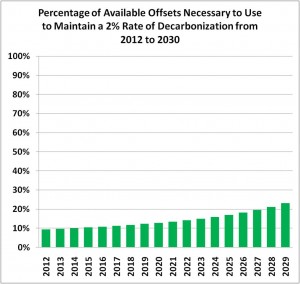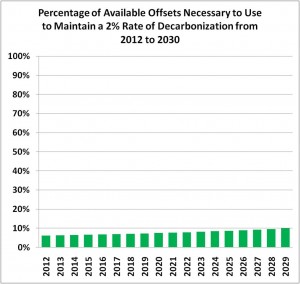“A Con for Our Time”
June 8th, 2009Posted by: Roger Pielke, Jr.
[UPDATED: See below]
Writing at the FT, London School of Economics economist William Buiter calls the American Clean Energy and Security Act of 2009 (otherwise known as Waxman-Markey) “a total con”:
[Under ACES] emissions will not be reduced. But that is inconsistent with the supposed desire to reduce emissions to 83 percent of their 2005 level by 2020 and to 17 percent of the 2005 level by 2050. Except that is it not inconsistent if there is no intention to reduce emissions at all, but instead every intention to permit them to be raised above their 2005 levels. And that is of course what is going on.
Here I go beyond Buiter’s cogent critique to add a few quantitative details to how offsets under the bill will allow emissions to rise essentially indefinitely.
First, lets start with some assumptions.
1. The scheme begins in 2012.
2. The scheme covers 85% of US emissions.
3. 85% of 2012 emissions are 6,078 million tonnes
4. The scheme has a goal of reducing emissions to 5,056 million tonnes by 2020 and 3,533 by 2030.
5. 2,000 tonnes of offset credits are available each year of the scheme
6. Unused offsets roll over and can be used in subsequent years
Under these assumptions we can reach a few interesting conclusions.
First, to achieve the 2020 emissions reduction goal under a scenario of 2.0% annual GDP growth requires decarbonization of the U.S. economy of about 4.0% per year. Under the faster rate of economic growth in the Obama Budget that rate of decarbonization needs to be 5.2% per year.
Second, to achieve the 2030 emissions reduction goal under a scenario of 2.0% annual GDP growth requires decarbonization of the US economy of about 5.0% per year. Under the faster rate of economic growth in the Obama Budget that rate of decarbonization needs to be 5.7% per year.
Since no one knows how to decarbonize an economy at rates of 4% or above per year over a period of decades, the authors of the ACES bill have provided the opportunity for the generous use of “offsets” — which means that credit can be claimed toward the ACES goals for reducing emissions (or more likely, reducing hypothetical future emissions) both inside and outside of the U.S. economy.
I was curious as to how many offsets would have to be used for the U.S. to maintain its historical rate of decarbonization of about 2% per year. So I have conducted the following exercise:
1. I projected US emissions at a 2% rate of decarbonization of the economy coupled with assumed economic growth of 2% per year.
2. I then compared this scenario with emissions reductions consistent with the targets in ACES for 2020 and beyond. [UPDATE: The first version of the graph I showed below used a rate of decarbonization faster than required by ACES to 2020, but consistent with a 2030 trajectory, the second graph shows a rate consistent with the 2020 trajectory.]
3. I assume that the difference between the 2% decarbonization scenario and the ACES scenario will be made up for entirely through use of offsets.
The question I want to answer is, what percentage of available offsets would be necessary to use to sustain a 2% rate of decarbonization? The answer surprised me and can be seen in the following graph.

What this graph shows is that only a small portion of available offsets would need to be used to sustain the historical rate of decarbonization of the U.S. economy [UPDATE] consistent with the ACES 2030 trajectory. Economic modelers like to call this “business as usual.” Whether the 2% rate results from business as usual, the effects of ACES, or a combination of both is irrelevant to this exercise.
[UPDATE} The graph below shows the rate consistent with the 2020 emissions reduction trajectory. The rates are different to 2020 and 2030 under ACES, which is why the graphs look different

(Methodological notes: I ignore the phase in of covered entities from 2012 to 2016 under ACES, making my exercise a bit conservative. Using a faster rate of growth, such as under the Obama Budget would increase the values for 2020 by about 3%.)
What this exercise shows is that it it would be possible under an offsetting scheme like that in ACES to avoid achieving decarbonization rates of 4% or greater by using only a small fraction of available offsets, and thus do absolutely nothing to change, much less transform, the U.S. energy system. William Buiter is correct — offsets are a “con for our time.”
June 8th, 2009 at 10:01 am
This is such a pathetic situation overall. While I lack the time to read all the detailed analyses from supporters and opponents of W-M, and I lean towards the arguments against, I can’t see its defeat as a good thing either.
Would it’s defeat be taken as a message to jump right in for a better bill? Is a better bill feasible in Congress? Or would defeat simply mean that a climate bill is off the table for a year or two or three? It seems that only the head-in-the-sand crowd can be happy with this situation. It’s a classic lose-lose situation for supporters of taking action.
June 8th, 2009 at 10:41 am
dean–I’m sure if WM doesn’t pass, another bill will be drafted. It’s even possible the next bill might be crafted so as to reduce CO2. In contrast, if WM passes, the chances of a bill that might actually achieve goals of those who want to reduce CO2 will be close to zero.
Given what a poor bill this is, watching political process unfold is a bit mind-boggling.
June 8th, 2009 at 11:55 am
Stay calm and repeat softly and slowly; The first three objectives of any Clean Climate Bill are (1) Tax Revenues, (2) Tax Revenues, and (3) Tax Revenues.
Then, Grasshopper, you shall attain a full understanding and a peaceful oneness with The Universe.
June 8th, 2009 at 12:09 pm
-3-EDaniel
I don’t want to disturb your Zen-like state, however, CBO suggests that net revenues aren’t in the cards for this bill:
http://www.cbo.gov/ftpdocs/102xx/doc10262/hr2454.pdf
If the carbon allowance price is less than assumed it will be a net money loser with respect to the deficit.
June 8th, 2009 at 2:02 pm
Lucia,
I don’t see how you can be so sure that a better bill will be written and introduced and pushed. Waxman is the Chair of the committee and one of the primary advocates in Congress for taking action, particularly among those in such a position of power. Will he write a new bill right away and be in a position to put this much energy in it? Will he also abandon the methods in this bill for a new one? Will Obama put energy into supporting a new bill or will he just focus on health care? It really doesn’t help much if a junior/freshman member of Congress pushes something better, because
they aren’t in a position to make it happen. In our system of government, if people in the right places don’t push it, it’s just a symbol.
I simply don’t see how anybody can be sure that the chance for replacing a climate bill that isn’t working well is so much worse than having to start from scratch. Maybe it will be, but how can you be sure?
June 8th, 2009 at 2:09 pm
The object of the bill is not to raise tax revenues. The object of the bill is to seem to do something while doing nothing. The objects of the Congress is to get the kooks off their backs while doing nothing that would get themselves voted out of office by the rest of us.
In my opinion, that’s a good thing. The less they “do” about global warming, the better.
June 8th, 2009 at 2:28 pm
Dean–
I’m sure another bill will be drafted. I didn’t say I was sure it would be better. It might be better. It also might be worse!
If passed, I think the chance that WM will be replaced by a better bill anytime soon is nearly zero. Could I be wrong? Sure. But in the first place, one needs time to drum up support to create a better bill. Would anyone introduce the better bill next year? The year after? How would they justify the new bill to fix the freshly passed old one that hasn’t even been given a chance to prove everyone how horrible it is?
Also once enacted and in place for 1 or 2 years, there are going to be lots of traders with vested interests in maintaining the market in permits. I don’t think it’s going to be easy to get rid of it.
June 8th, 2009 at 3:57 pm
Lucia,
If W&M passes it may be impossible to repeal entirely but lobbying by various interest groups demanding more free credits and/or increased limits will further erode any carbon pricing mechanism.
Incidently, that is why all ‘carbon pricing’ mechanisms will ultimately fail because there will always be politically connected parties that are hurt by the rules that will be able to negotiate exemptions and/or special treatment. This, of course, will lead to even more requests for special treatment.
June 8th, 2009 at 7:50 pm
“Since no one knows how to decarbonize an economy at rates of 4% or above per year over a period of decades”…..What is the highest, sustainable annual rate of decarbonization that is possible currently?
June 8th, 2009 at 8:04 pm
Raven–
If you are suggesting WM could be incrementally made worse, I agree with you. Interest groups will definitely lobby for more credits and increased limits.
June 8th, 2009 at 8:17 pm
In any con, there is the mark, who is being conned, and most cons involve misdirection. Those involved in the con hope to profit by it. That is the purpose of running a con. Who is the mark? What is the misdirection? What is the actual purpose — who is hoping to profit by duping the mark?